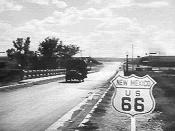John Steinbeck is an author known worldwide for his compelling stories and novels. One such novel is The Grapes of Wrath. This novel was written to expose the plight of those dispossessed from their lands by the Great Depression. Steinbeck uses several literary elements to help relate the story to the reader. In The Grapes of Wrath, as in his other works, Steinbeck relies on the use of symbolism to strengthen and enhance the plot.
By far, the most involved example of symbolism is found in the character of the preacher, Jim Casy. Casy not only is a Christ figure but also embodies the belief of Transcendentalism. These are supported by many examples throughout the story. Some of these examples are easily noticed, others require more thought to be understood. The symbolism found in Jim Casy does a great deal to bring together the events that make up the story.
That Casy is a Christ figure can be shown in several ways. One obvious (or perhaps not as obvious as it may seem) similarity between Casy and Christ is that they share the same initials, J.C. It was not merely coincidence that Steinbeck chose the name Jim Casy. Initials, however, are not the only thing that Casy and Christ share. Another similarity is that both men went into the wilderness before coming back to the public life. Christ went into the desert for a period of forty days of intense prayer with the Father before coming into his public life of preaching. Casy follows a slightly different, but on the whole, similar pattern. Casy tells the reader that he had been a preacher, but had become unsure of what holy really means. He spent four years away from society, and after spending some time with the...



Good job
great 10th grade paper. I'd reccomend a thesis, or more specific message about your analysis and what conclusions you draw from the analysis. Good analysis of symbolism, allusion, and other literary tools-of-the-trade
6 out of 6 people found this comment useful.